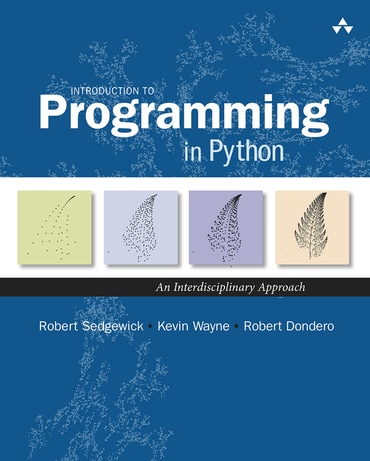
Introduction to Programming in Python: An Interdisciplinary Approach, 1st edition
- Robert Sedgewick |
- Kevin Wayne |
- Robert Dondero |
Title overview
Introduction to Programming in Python: An Interdisciplinary Approach emphasizes interesting and important problems, not toy applications. The authors focus on Python's most useful and significant features, rather than aiming for exhaustive coverage that bores novices. All of this book's code has been crafted and tested for compatibility with both Python 2 and Python 3, making it relevant to every programmer and any course, now and for many years to come.
An extensive amount of supplementary information is available at introcs.cs.princeton.edu/python. With source code, I/O libraries, solutions to selected exercises, and much more, this companion website empowers people to use their own computers to teach and learn the material.
- A broad-based, applications-based approach: teaches Python through examples from science, mathematics, engineering, and commercial computing
- Focuses on what matters most: the most useful and important Python language features
- Teaches through code tested for compatibility with Python 2.x and Python 3.x
- Includes question-and-answer sections, exercises, and creative exercises throughout
Table of contents
Preface xiii
Chapter 1: Elements of Programming 1
1.1 Your First Program 2
1.2 Built-in Types of Data 14
1.3 Conditionals and Loops 56
1.4 Arrays 100
1.5 Input and Output 140
1.6 Case Study: Random Web Surfer 188
Chapter 2: Functions and Modules 209
2.1 Defining Functions 210
2.2 Modules and Clients 248
2.3 Recursion 290
2.4 Case Study: Percolation 322
Chapter 3: Object-Oriented Programming 351
3.1 Using Data Types 352
3.2 Creating Data Types 402
3.3 Designing Data Types 450
3.4 Case Study: N-Body Simulation 496
Chapter 4: Algorithms and Data Structures 511
4.1 Performance 512
4.2 Sorting and Searching 556
4.3 Stacks and Queues 590
4.4 Symbol Tables 634
4.5 Case Study: Small-World Phenomenon 684
Context 729
Glossary 733
Index 739
Each section concludes with Q&A and Exercises.
Author bios
Robert Sedgewick is the William O. Baker professor of computer science at Princeton University. He has held visiting research positions at several advanced research laboratories and serves on the Adobe Systems board. He is also the coauthor (with Kevin Wayne) of Introduction to Programming in Java and Algorithms, Fourth Edition (both from Addison-Wesley).
Kevin Wayne is the Phillip Y. Goldman senior lecturer in computer science at Princeton University, where he has taught since 1998. He is an ACM Distinguished Educator and holds a Ph.D. in operations research and industrial engineering
from Cornell University.
Robert Dondero is a lecturer in computer science at Princeton University. He has taught there since 2001, earning eight excellence in engineering education awards, and a lifetime achievement award for excellence in teaching. He holds
a Ph.D. in information science and technology from Drexel University.